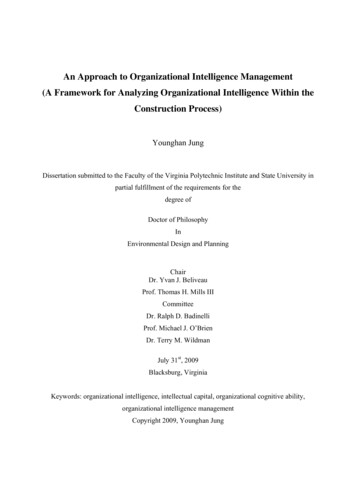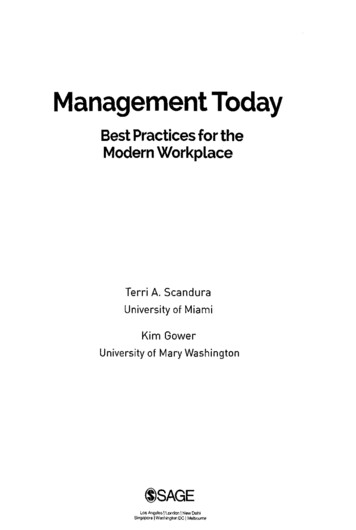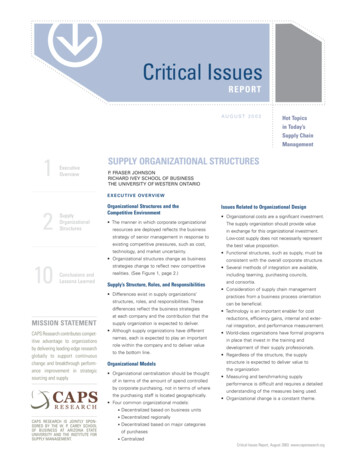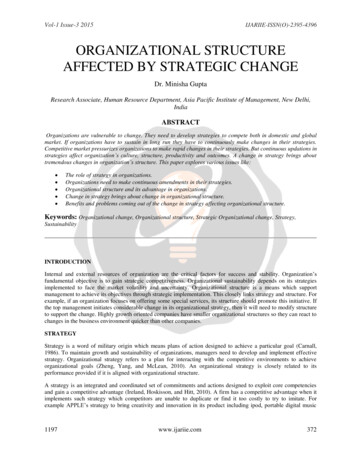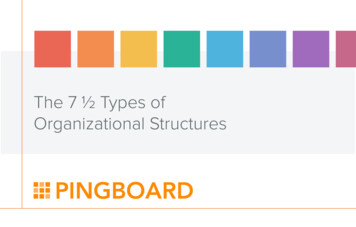
Transcription
The 7 ½ Types ofOrganizational Structures
Without Order,There is ChaosLike it or not, structure brings order. As an organizationgrows, there is more risk of chaos without structure.In an organization, org structure does 2 things:playeClarifies roles & reporting relationshipsplayeSupports good communicationAnd it results in:playeEfficient and effective work process flowplayeMore productive employeesinfo@pingboard.com / 1-877-733-5157 / www.pingboard.com
A Brief HistoryFrom where have we come?playeplayeplayeplayeplayeFirst org chart in 1855 by the New York andErie RailroadUntil the early 1950s, most U.S. companieswere functionally organizedLate 1950s- 1960s - Economic and productgrowth lead to complexities divisional/productstructures sought to control1970s brought globalization and increasedregulations which led to matrix structuresLate 1970s until today - organizations havesought to be more flexible and creative ininfo@pingboard.com / 1-877-733-5157 / www.pingboard.com
The Science behindStructureAccording to a study by McKinsey and Gallup:playe84% of U.S. employees were matrixed to some extentplaye49% of employees serve on multiple teams some daysplayeplayeplaye18% of employees serve on multiple teams every workday but withdifferent people, though mostly reporting to the same manager17% of employees report to different managers in their work withdifferent teamsOrganizations with clear and accountable roles have a 76% probabilityof achieving top-quartile organizational healthinfo@pingboard.com / 1-877-733-5157 / www.pingboard.com
How AreYou Organized?MYCOMPANYNot every organization isorganized the same. Exactlyhow it is organized depends on:playeplayeThe functional groupings ofwork processesMYCOMPANYThe natural groupings ofteams, work groups or unitsinfo@pingboard.com / 1-877-733-5157 / www.pingboard.com
7 ½ Common BusinessOrganizational ACRACYCUSTOMERTRIBES & SQUADSMPANYinfo@pingboard.com / 1-877-733-5157 / www.pingboard.com
Matrix OrganizationalStructureCEOFeatures:playe Reporting levels both horizontally as wellas vertically with cross-companyteamworkplaye Employees may be part of a functionalgroup (i.e. engineer) while serving on ateam (i.e. a specific product)Advantages:playe Employees have responsibility for theirdepartment and organizational projectsplaye Cross-team collaboration minimizesdepartmental and data silosChallenges:playe Employees may receive direction fromtwo different managersplaye It may be difficult to prioritize workresponsibilitiesCorporate StaffManagerAdmin & eringManagerMarketingProject AProject BProject CExample of a Matrix Organizationplaye Starbucksinfo@pingboard.com / 1-877-733-5157 / www.pingboard.com
Functional OrganizationalStructureCEOProject ionalResourceFunctionalResourceFeatures:playe Individuals are grouped by specific functionsperformedplaye Common departments are organized byseparating each area and managing themindependent of the othersAdvantages:playe Functions are separated by expertiseplaye There are clear roles, responsibilities andlines of commandChallenges:Different functional areas can turn into silosthat focus only on their area of responsibilitiesplaye There can be a lack of collaboration betweendepartmentsplayeExample of a Functional Organizationplaye Microsoftinfo@pingboard.com / 1-877-733-5157 / www.pingboard.com
Product OrganizationalStructureCEOFeatures:playe Company is organized by specificproduct typeplaye Each product has an executiveleader who oversees everythingrelated to that product lineAdvantages:playe Products are organized by categoryplaye There are clear roles, responsibilitiesand lines of commandChallenges:playe Each product division can createcompletely separate processesplaye The lack of cross-productcollaboration can result induplicative processes andinefficienciesPresidentProductGroup 1ProductionSalesProductGroup 2R&DAccountingProductionSalesProductGroup 3ProductionR&DSalesR&DAccountingAccountingExample of a Product Organizationplaye Johnson & Johnsoninfo@pingboard.com / 1-877-733-5157 / www.pingboard.com
Customer OrganizationalStructureCEOFeatures:playe Company is organized by customer typeplaye Customer expectations are met by acustomized service approachAdvantages:playe A customer-centered structure specializesin the needs of each customer groupplaye Customers receive more consistentexperience across channels andtouchpointsChallenges:playe The needs of different customer types maybe ignoredplaye Each customer division may compete withcorporate resources, such as ITChief CustomerOfficer (CCO)RetailFinanceOnlineCustomerServiceTechnology& ITMarketingHR & LegalCustomerExperienceExample of a Customer Organizationplaye Tumiinfo@pingboard.com / 1-877-733-5157 / www.pingboard.com
Geographic OrganizationalStructureWesternSales ManagerSales RepsGeneralSales ManagerFeatures:playe Organization is dispersed across one or moregeographic regionsplaye Typically, a central oversight person leads eachgeographic regionCentralSales ManagerAdvantages:playe Logistical demands and differences in geographiccustomer needs can be better supportedplaye Each division can focus its resources and talent to onlyits own territorySales RepsEasternSales ManagerSales RepsChallenges:playe Each region may operate with its own processes andprocedures, creating inefficienciesplaye Regions often compete with each other, establishing ahostile corporate environmentExample of a Geographic Organizationplaye Ford Motor Companyinfo@pingboard.com / 1-877-733-5157 / www.pingboard.com
Flat StructureFeatures:playe Small number of levels and broad span ofmanagement at each levelplaye Every employee is given equal footing sodecisions are made in collaboration orautonomouslyAdvantages:playe Employees feel like they are allcontributing equally and therefore similarlyvaluedplaye It’s a simple structure for smallercompanies where often people holdmultiple roles and reporting relationshipsare sometimes unnecessaryChallenges:Without structure, decisions are made as ademocracy but often can be slowed aseveryone has a sayplaye Employees can question who isresponsible for each task so creativity ctivity can sufferExample of a Flat Organizationplaye REVOLVE Clothinginfo@pingboard.com / 1-877-733-5157 / www.pingboard.com
HolacracyFeatures:playe Respects the creativity and openness of a flatorganization but still has some hierarchyplaye Departments and roles are blended sodecisions can be made from anyone andanywhereAdvantages:playe People are organized around Work as opposedto departments or seniorityplaye A hybrid approach appreciates both structureand autonomy so employees have authoritywithin boundariesChallenges:Without any designated middle management,decisions can be delayedplaye An open environment must balance creativityand collaboration with productivityplayeExample of a Holacratic Organizationplaye Zapposinfo@pingboard.com / 1-877-733-5157 / www.pingboard.com
Tribes & SquadsTribes & Squads is a form of a Matrix organization but instead of functional leaders managing the teams,project leaders do. The functional leaders may manage other things, such as career paths.Features:playe Development or functional teams may berenamed “Squads”, “Crews” or “Troops” who owna certain part of functionality from end to endplaye “Tribes” are a collection of squads within thesame business area, such as a product or divisionplaye A “Guild” is a community of members across theorganization who want to share knowledge, tools,and practicesAdvantages:playe Promotes team collaboration and innovationplaye Project leaders who are more familiar with theprojects are in charge rather than functionalleadersChallenges:Can take time to get used to new jargonplaye People outside of the organization may have adifficult time understanding organizational RSQUAD SQUAD SQUAD SQUADplayeExample of a Tribal Organizationplaye Spotifyinfo@pingboard.com / 1-877-733-5157 / www.pingboard.comCHAPTERSQUAD SQUAD SQUAD SQUADHenrik Kniberg & Anders Ivarsson Oct 2012
No matter how your organization is structured, Pingboard can help connect youremployees like never before. When employees know where they fit into thecompany and can find any coworker with the swipe of a finger, engagement andproductivity soar. Let Pingboard bring relationships to your structure.Read more about why our clients love oursoftware. Build your Org Chart in minutes forFREE using Pingboard today.Get Started for Free info@pingboard.com / 1-877-733-5157 / www.pingboard.com
Product Organizational Structure Features: playe Company is organized by specific product type playe Each product has an executive leader who oversees everything related to that product line Advantages: playe Products are organized by category playe There are clear roles, responsibilities and lines of command Challenges: playe Each product division can create

